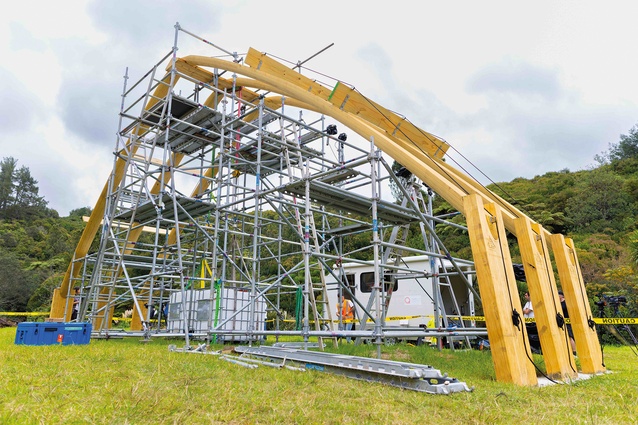Historic Bay of Plenty wharenui to be rebuilt
Following tests in Ōpōtiki in April, which demonstrated that Māori construction techniques are able to withstand major earthquakes, architect and researcher Professor Anthony Hōete and Māori architectonic researcher Jeremy Treadwell plan to rebuild an historic Bay of Plenty wharenui, Tānewhirinaki.
The pair, along with a wider team from the University of Auckland, used the construction technique mimiro to create a full-scale timber structure, which they successfully tested against earthquake requirements for modern buildings. “Our seismic tests demonstrated the structure can withstand much stronger earthquakes than the Napier one that caused critical damage to the original wharenui in 1931,” said Hōete. The team designed and built the timber portals using interlocking compression joints instead of bolting parts together and then used tightened ropes to pull the structure to the ground like a tent. The horizontal strength of the structure was tested with a jeep’s winch and its vertical strength was tested with water weights.
The project received funding from Toka Tū Ake EQC (Earthquake Commission). “This work aligns well with our goal to improve Aotearoa’s resilience to natural hazards,” said Toka Tū Ake EQC Chief Resilience and Research Officer Dr Jo Horrocks. Investing in Māori researchers and matauranga Maori has been a key focus of the organisation’s biennial grants this year. The research was also supported by QuakeCoRE, the Centre of Research Excellence for seismic resilience and the Endangered Wooden Architecture Programme at Oxford Brookes University.
The team worked closely with Ngāti Ira o Waioweka, who built the original Tānewhirinaki wharenui on Opeke marae near Ōpōtiki after the 1860 New Zealand Wars. It was destroyed in the 7.8 magnitude earthquake in 1931. The new structure, to be built over the next three to five years, will form an outer whare; the original carvings will be sensitively attached to the inside.










